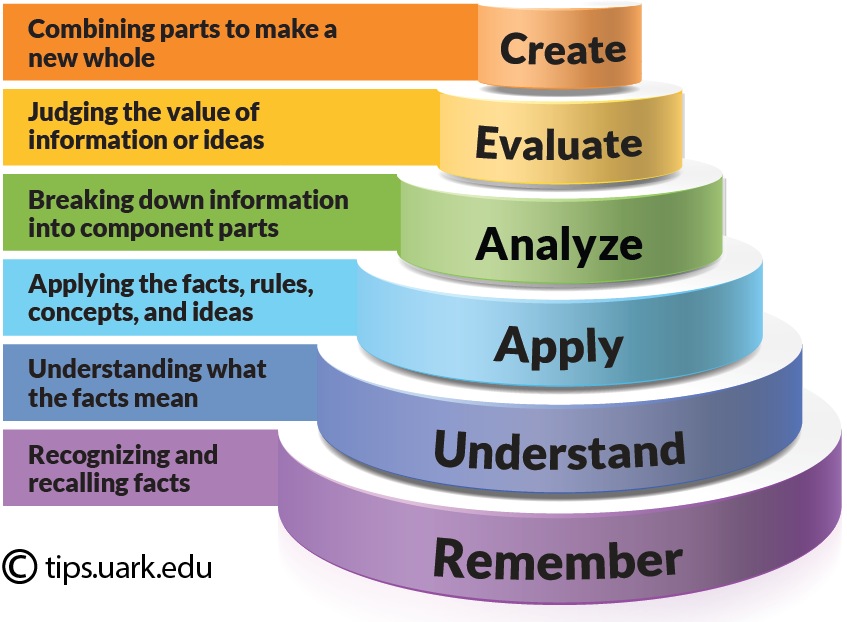Taxonomies of the Cognitive Domain

|
Bloom's Taxonomy 1956
|
Anderson and Krathwohl's Taxonomy 2001
|
|---|---|
|
1. Knowledge: Remembering or retrieving previously learned material. Examples of verbs that relate to this function are:
|
1. Remembering: Recognizing or recalling knowledge from memory. Remembering is when memory is used to produce or retrieve definitions, facts, or lists, or to recite previously learned information. |
|
2. Comprehension: The ability to grasp or construct meaning from material. Examples of verbs that relate to this function are:
|
2. Understanding: Constructing meaning from different types of functions be they written or graphic messages or activities like interpreting, exemplifying, classifying, summarizing, inferring, comparing, or explaining. |
|
3. Application: The ability to use learned material, or to implement material in new and concrete situations. Examples of verbs that relate to this function are:
|
3. Application: The ability to use learned material, or to implement material in new and concrete situations. Examples of verbs that relate to this function are: |
|
4. Analysis: The ability to break down or distinguish the parts of material into its components so that its organizational structure may be better understood. Examples of verbs that relate to this function are:
|
4. Analyzing: Breaking materials or concepts into parts, determining how the parts relate to one another or how they interrelate, or how the parts relate to an overall structure or purpose. Mental actions included in this function are differentiating, organizing, and attributing, as well as being able to distinguish between the components or parts. When one is analyzing, he/she can illustrate this mental function by creating spreadsheets, surveys, charts, or diagrams, or graphic representations. |
|
5. Synthesis:
The ability to put parts together to form a coherent or unique new whole. Examples of verbs that relate to this function are:
|
5. Evaluating: Making judgments based on criteria and standards through checking and critiquing. Critiques, recommendations, and reports are some of the products that can be created to demonstrate the processes of evaluation. In the newer taxonomy, evaluating comes before creating as it is often a necessary part of the precursory behavior before one creates something. |
|
6. Evaluation: The ability to judge, check, and even critique the value of material for a given purpose. Examples of verbs that relate to this function are:
|
6. Creating: Putting elements together to form a coherent or functional whole; reorganizing elements into a new pattern or structure through generating, planning, or producing. Creating requires users to put parts together in a new way, or synthesize parts into something new and different creating a new form or product. This process is the most difficult mental function in the new taxonomy. |
(http://valuediversity-teacher.co.uk/wp-content/uploads/2017/07/blooms.png)
BLOOM’S TAXONOMY ACTION VERBS
A printable document of this information can be found here.
|
Level |
Knowledge |
Comprehension/ Understand |
Application |
Analysis |
Synthesis/Create |
Evaluation |
|
Definition |
Remember previously learned information. |
Demonstrate an understanding of the facts. |
Apply knowledge to actual situations |
Break down objects or idea into simpler parts and find evidence to support generalizations |
Compile component ideas into a new whole or propose alternative solutions. |
Make and refend judgments based on internal evidence or external criteria. |
|
Verbs |
Copy Define Duplicate Enumerate Identify Label List Locate Match Memorize Name Order Outline Recognize Relate Recall Recite Repeat Reproduce Record State Tabulate Tell |
Describe Discuss Explain Express Extend Generalize Indicate Locate Paraphrase Rewrite Review Select Summarize Translate Trace |
Apply Administer Change Chart Compute Demonstrate Determine Discover Employ Give Examples Illustrate Interpret Manipulate Model Operate Practice Show Sketch Solve Transfer Use |
Analyze Appraise Breakdown Calculate Catagorize Compare Contrast Criticize Diagram Differentiate Discriminate Distriguish Examine Experiment Identify Illustrate Point Out Seperate Subdivide Survey Test Validate |
Anticipate Arrange Assemble Collect Combine Comply Compose Construct Create Design Develop Devise Formulate Generate Hypothesize Plan Prepare Rearrange Reconstruct Reorganize Set up Simulate Speculate Structure Synthesize |
Appraise Argue Assess Choose Compare Conclude Critiquing Defend Estimate Evaluate Infer Judge Justify Persuade Rate Recommend Select Support Value |
